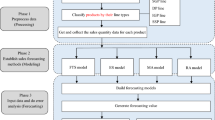Abstract
This paper proposes a new method for long-term forecasting of level and structure of market demand for industrial goods. The method employs k-means clustering and fuzzy decision trees to obtain the required forecast. The k-means clustering serves to separate groups of items with similar level and structure (pattern) of steel products consumption. Whereas, fuzzy decision tree is used to determine the dependencies between consumption patterns and predictors. The proposed method is verified using the extensive statistical material on the level and structure of steel products consumption in selected countries over the years 1960–2010.
Access this chapter
Tax calculation will be finalised at checkout
Purchases are for personal use only
Similar content being viewed by others
References
Rebiasz, B., Gawel, B., Skalna, I.: Hybrid framework for investment project portfolio selection. In: Computer Science and Information Systems (FedCSIS), 2014 Federated Conference on, pp. 1117–1122 (2014)
Malenbaum, W.: World demand for raw materials in 1985 and 2000. McGrow-Hill, New York (1975)
Evans, M.: Modeling steel demand in the UK. Ironmaking Steelmaking 1, 19–23 (1996)
Ghosh, S.: Steel consumption and economic growth: evidence from India. Resour. Policy 1, 7–11 (2006)
Labson, B.S.: Changing patterns of trade in the world iron ore and steel market: an econometric analysis. J. Policy Model. 3, 237–251 (1997)
Rebiasz, B., Garbarz, B., Szulc, W.: The influence of dynamics and structure of Polish economic development on home consumption of steel products. Metallurgist-Metall. News 9, 454–458 (2004)
Roberts, M.C.: Predicting metal consumption: the case of US steel. Resour. Policy 1, 56–73 (1990)
Roberts, M.C.: Metal use and the world economy. Resour. Policy 3, 183–196 (1996)
Rebiasz, B.: Polish steel consumption 1974–2008. Resour. Policy 1, 37–49 (2006)
Hougardy, H.P.: Zukünftige Stahlentwicklung. Stahl Eisen 3, 85–89 (1999)
Altman, E.I., Macro, G., Varetto, F.: Corporate distress diagnosis: comparison using linear discriminant analysis and neural networks. J Bank Financ 18, 505–529 (1994)
Andres, J., Landajo, M., Lorca, P.: Forecasting business profitability by using classification technique: a comparative analysis based on Spanish case. Eur. J. Oper. Res. 2, 518–542 (2005)
Chen, Z.: Data Mining and Uncertain Reasoning—An Integrated Approach. Wiley, New York (2001)
Rastogi, R., Shim, K: A decision tree classifier that integrate building and pruning. Proceedings of the 24th International Conference on Very Large Databases (VLDB’98), pp. 405-415, (1998)
Tsujimo, K., Nishida, S.: Implementation and refinement of decision tree using neural network for hybrid knowledge acquisition. Artif. Intell. Eng. 9, 265–275 (1995)
Thomassey, S., Fiordaliso, A.: A hybrid forecasting system based on clustering and decision trees. Decis. Support Syst. 42, 408–421 (2006)
Hansen, N.K., Salamon, P.: Neural network ensembles. IEEE Trans. Pattern Anal. Mach. Intell. 12, 993–1003 (1990)
Zhou, Z.H., Jiang, Y.: NeC4.5: neural ensemble based C4.5. IEEE Trans. Knowl. Data Eng. 16, 770–773 (2004)
Umano M.: Fuzzy decision trees by fuzzy ID3 algorithm and its application to diagnosis systems. Fuzzy Systems, 1994. In: Proceedings of the Third IEEE Conference on IEEE World Congress on Computational Intelligence, vol. 3, pp. 2113–2118 (1994)
Crompton, P.: Future trends in Japanese steel consumption. Resour. Policy 2, 103–114 (2000)
Author information
Authors and Affiliations
Corresponding author
Editor information
Editors and Affiliations
Rights and permissions
Copyright information
© 2016 Springer International Publishing Switzerland
About this paper
Cite this paper
Gaweł, B., Rębiasz, B., Skalna, I. (2016). Data Mining Methods for Long-Term Forecasting of Market Demand for Industrial Goods. In: Wilimowska, Z., Borzemski, L., Grzech, A., Świątek, J. (eds) Information Systems Architecture and Technology: Proceedings of 36th International Conference on Information Systems Architecture and Technology – ISAT 2015 – Part IV. Advances in Intelligent Systems and Computing, vol 432. Springer, Cham. https://doi.org/10.1007/978-3-319-28567-2_1
Download citation
DOI: https://doi.org/10.1007/978-3-319-28567-2_1
Published:
Publisher Name: Springer, Cham
Print ISBN: 978-3-319-28565-8
Online ISBN: 978-3-319-28567-2
eBook Packages: EngineeringEngineering (R0)




